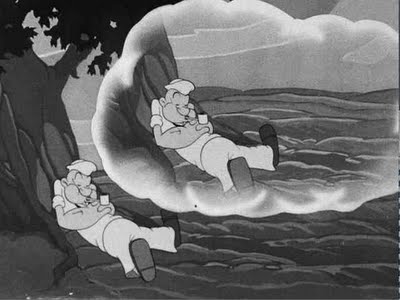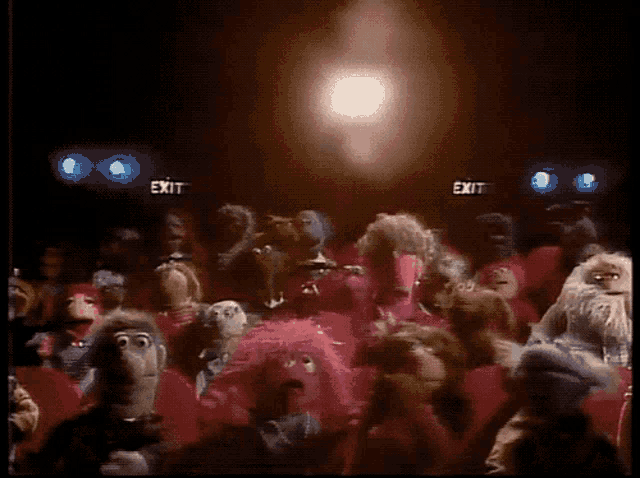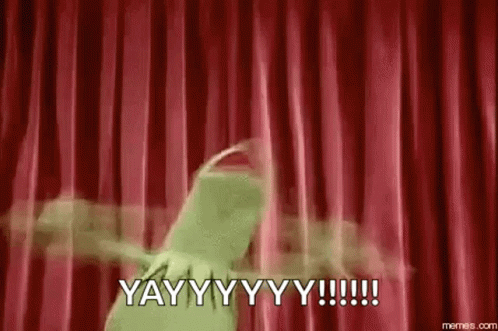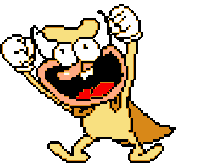After much internal debate, I think I'm going to ramble a lot about how my gaming-drenched childhood influenced the kinds of stories I write today.
There was this fear when I was a kid that if someone played too many games, they'd lose most of their language prowess from disuse. It was a myth my parents believed firmly, despite young me gravitating towards text-dense games. To put into perspective just how much my love of reading influenced the way I played, I would walk around in Paper Mario every day for weeks with no intent of actually beating the game. I just wanted to read all of Goombario's dialogue. He had an entire paragraph of unique flavor text for every individual character and every individual segment of the map (and occasionally some of the objects, too). For a kid who loved to learn and read, Goombario just made sense. For every other player, he was probably a useless little chestnut to ignore forever as soon as Bombette joined the party.

Chatty Chestnut Child
Paper Mario had a positive impact on the way I write dialogue in my prose, and to this day I cite it as some of the most skillful dialogue writing in gaming history. But there is another game that impacted my writing in a much bigger way.
Backstory first: my earliest experiences with video games were "restricted." Mom allowed me to play games using my teenage brothers' consoles, but I had to promise not to save over their files. So, because I couldn't start my own file to see the game from the beginning, I didn't realize that some games were story based. (My earliest experience was a Pac-Man arcade machine and a few rounds of Super MarioKart...not exactly lore heavy!)
This restricted gaming worked out well with the platformers my brothers liked to play. It was fun to hop from area to area and simply challenge yourself to beat different levels at my own pace. Donkey Kong Country quickly earned a spot in my heart.
It worked out less well with games where watching the story is necessary for experiencing the game. As a result, for a long time I thought Ocarina of Time was an open world game... lots to explore, loose plot that could be ignored most of the time. I couldn't make sense of the Temples at all. It was only when I rented a copy from Blockbuster for myself out of curiosity ("but Mylo, we have that game at home") that I discovered an entire new layer I hadn't seen before. Enamored by this new idea of stories and games combined, I'd rent Ocarina of Time every chance I could, just to see how far I could progress before returning it.
And I was
awful at it. It took over two months for me to realize I had to light the spiderweb on the floor on fire to get to Gohma and I'm sure I'm forgetting other dumb stuff I did too.
 Side Note: I hated this guy as a kid. Now I don't.
Side Note: I hated this guy as a kid. Now I don't.As you might expect, I made lots of fan art and cute little kid fan fiction about the game, even a guidebook called I Am a Kokiri. Then Majora's Mask came out, and I knew from just the first ten minutes of playing that this was going to be an adventure I'd never forget.
First off, the game started with a character undergoing an involuntary transformation into a nonhuman being. Metamorphosis in general is a fantasy trope which has fascinated me for my entire life and continues to appear in most of my work to this day. The back of the box promised even more of it, and the fact that the NPCs reacted differently to the different forms you could take was like direct shots of dopamine to my brain.
The game also revolved around masks, a mostly-cosmetic item from the first game that I was very fond of. I love masks in general, and by extension all sorts of costumes. Some of the masks looked hysterical on Link, others made him look cool, and there was nothing I wanted to do more than fill every slot on that Mask subscreen. I'm still amused by the way the "sexy" Great Fairy head looks on Links little body.
The biggest surprise--and the most welcome one--was the elevation of the Deku. In Ocarina of Time, Deku Scrubs--which are like Octopus/Ent hybrids--were a simple projectile-spitting baddie within the Deku Tree. The Business Scrub variant (much taller!) appeared in a few hidden locations and sold overpriced items upon defeat, while Mad Scrubs (more aggressive) guarded the entrance to the Forest Temple.
I loved them from the instant I saw them thanks to their cute appearance. What captured my imagination most was that, unlike the other monsters in the game... they talked!
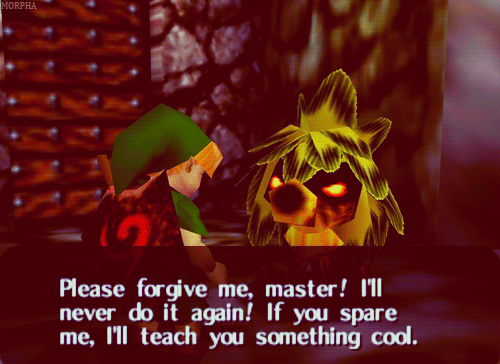
At some point early in my childhood--too early for me to remember exactly when--I became fascinated by "henchman" characters in cartoons. It was partly because I identified with them--they weren't pretty or "perfect" like the hero characters. They were often loudmouthed and clumsy. And they did things that got them into big trouble. (I was a troublemaker!) It was probably because of this internal identification that they seemed like "missed opportunities" storywise. I started looking at these characters differently and wanting to know... what was their culture like? How often did they train? When they weren't making trouble, what did they do all day? What kinds of foods did they eat? What games did they play? In the case of things like Koopas or Kremlings, were there enough of them to fill an entire city, or just a small village?
Tangentially related, there's a fantastically stupid episode of Chalk Zone that covers the "rigorous" training of big bad Skrawl's minions, the Beanie Boys. It even explains why they all look alike. Am I happy this content exists? You betcha.
 Only five more minutes till we piss off Skrawl, ha-ha-ha-ha-ha!
Only five more minutes till we piss off Skrawl, ha-ha-ha-ha-ha!
Giving villainous characters any sort of three-dimensionality wasn't typically on the mind of most children's creators at the time, so I had to just make things up to quench my thirst for "minion content." With Majora's Mask, my prayers were answered for the first time!
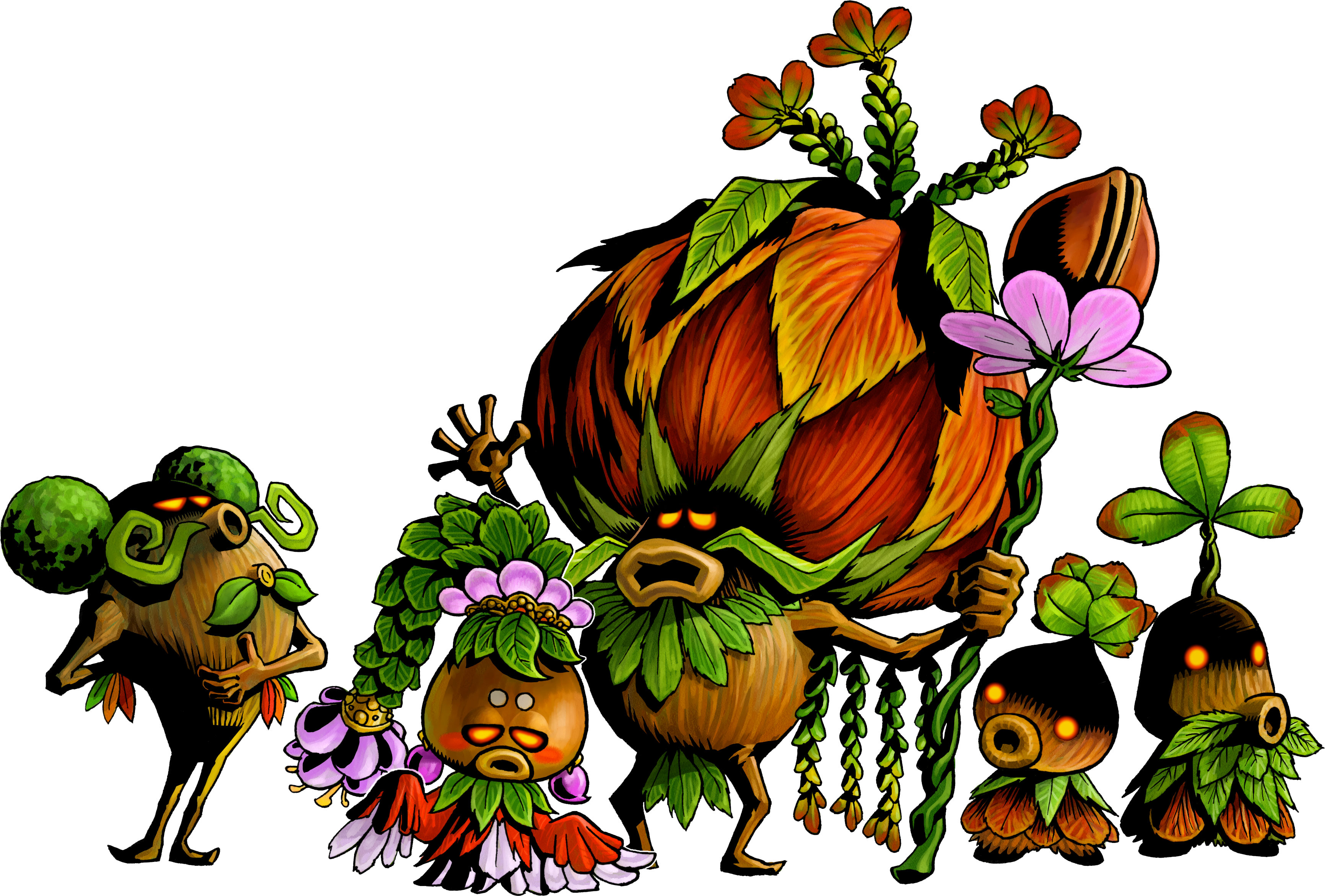
HALLELUJIAH!Nintendo brought me a shrubbery in the best way possible. The Deku were finally given their own agency as a race of swamp-dwellers in Termina, with their own Royal Family and even a butler with a deeply tragic secret. Not only that, Link's Deku Scrub form turned them into
a playable race--completely unprecidented! This was a huge leap from the Deku's inclusion as one-and-done enemies in Ocarina of Time. I'm not sure what posessed Miyamoto and the Zelda dev crew to decide to develop such an unusual enemy into a full-blown people, but I've never once complained about it. It's a bit of a pity they've been shelved for the fan-favorite Koroks... but I like those, too.
Setting the Deku aside, many years after getting Majora's Mask I dusted it off as a teenager to try to finally beat the game. When I did, I discovered a somber story, but not one that was so bleak that it was without its humor. It touched on a lot of mature themes that I'd missed as a kid--for instance, it not only depicted the looming threat of the moon, but showed the way each character coped (or didn't cope!) as it got closer, even with a lot of blink-and-you'll-miss-it content hidden in those last five minutes. Even the "recycled" content like character models are built upon with brand new animations much livelier than the ones in Ocarina of Time, with Link's model given a huge makeover with new animations that showcase his skills as a hero carried over from his last adventure. The game is so rich in both content and story, especially in its dialogue, that I consider it Nintendo's masterpiece.

Majora's Mask is the kind of story I aspire to create: one that has an underlying darkness underneath all the whimsical characters and upbeat music, one that gets darker as the story progresses, and one that still has its happy ending despite it all.
I don't think I'm skilled enough to write this kind of story yet.
But I'd like to be.
So to go back to my original point, I love story-heavy games and everyone who told me I couldn't improve my storytelling by playing video games is a closed-minded dummy and that's that.
(Phew... I think I'll try to write a shorter post next time.)




